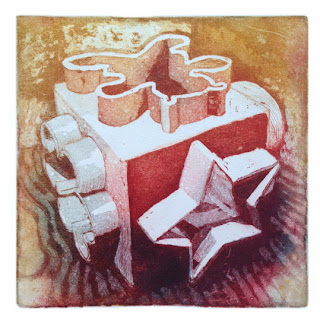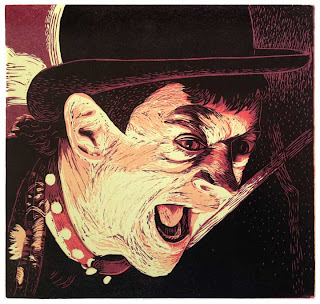I've been very busy doing science experiments.
In the quest for non-toxic ways to make etchings I've been away from the blog messing around in the garage, but now its time to post all the results.
First- copper sulphate solution has replaced my old nitric acid etching, and has been a massive success.
I followed the examples from Zea Mays printstudio's website:
http://zeamaysprintmaking.com/green-printmaking/technical-pages/etching-zinc-copper-sulfate-mordant
The etching works on a sub-atomic level (!), swapping particles of zinc and copper, rather than corroding the metal with nasty acid. The positives are great- you can do it at home, you don't lose your fingers, and there are no fumes to harm you. Obviously you won't want to eat the stuff, but there is not much else which can harm you. If you want to take it up there are numerous websites explaining the method. I get all the supplies from
HawthornPrintmaker.
BIG
The best resist used for copper sulphate etching on zinc is BIG- Baldwin's Intaglio Ground. It is rolled on the zinc plate like lino ink, but in thin layers. You can draw on it, press things into it to take the resist off in patterns, and then heat it to make it hard and tough. Along with other videos you can see it at work here:
http://www.printmakingstudio.co.uk/index.php?option=com_content&view=article&id=67&Itemid=30
Copper sulphate line test- times measured in minutes
Icing sugar aquatint
This has totally revolutionised the way I do aquatint. Rosin is the traditional way, which is very toxic, and has been linked to cancer, so I wanted to stop using it right away. For a very good guide on icing sugar aquatint visit this page:
http://zeamaysprintmaking.com/green-printmaking/technical-pages/icing-sugar-aquatint-10
The aquatint is actually better than any I've done using rosin. Its very reliable, and has an even tone.
Test print of icing sugar aquatint
Coffee Lift
This is usually called Sugar Lift, but I'm using a strong Nescafé and hot water mix. It enables a lovely painterly or ink drawing style to your line. Its a bit like working in reverse- adding to take away. The coffee drawing when dried has BIG carefully rolled on top, then baked to cure into a hard ground. Leave it for an hour to set fully, and then in a bath of comfortably hot water gently stroke with cotton wool. the areas you painted with coffee will float off very quickly. Pat dry and then you can either etch straight away, or add an icing sugar aquatint on top (for lovely dark areas).
Coffee lift plate with icing sugar aquatint laid, ready to etch.
Etched and ready to print. The lighter grey areas were etched at 2mins then covered in a resist to stop bite, then and the darker areas for a further 5mins.
The print
Looking at the lighter tones- they should be darker, and even maybe the same as the darkest.
A combination of line and aquatint
plate bitten and ready to print
The print.
The lighter areas at the top is where I didn't cure the BIG enough. Also the white lines show that the ink wasn't pushed into the fine lines enough. I'll have to get an old fashioned dabber to fix this.










































